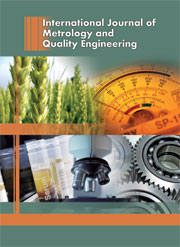Crossref Citations
This article has been cited by the following publications. This list is generated based on data provided by
Crossref.
Kok, G J P
Harris, P M
Smith, I M
and
Forbes, A B
2016.
Reference data sets for testing metrology software.
Metrologia,
Vol. 53,
Issue. 4,
p.
1091.
Arezki, Yassir
Zhang, Xiangchao
Mehdi-Souzani, Charyar
Anwer, Nabil
and
Nouira, Hichem
2018.
Investigation of minimum zone assessment methods for aspheric shapes.
Precision Engineering,
Vol. 52,
Issue. ,
p.
300.
Arezki, Yassir
Mehdi-Souzani, Charyar
Anwer, Nabil
and
Nouira, Hichem
2018.
Reference data simulation for L∞ fitting of aspheres.
Procedia CIRP,
Vol. 75,
Issue. ,
p.
331.
Linares, J.M.
Goch, G.
Forbes, A.
Sprauel, J.M.
Clément, A.
Haertig, F.
and
Gao, W.
2018.
Modelling and traceability for computationally-intensive precision engineering and metrology.
CIRP Annals,
Vol. 67,
Issue. 2,
p.
815.
Hutzschenreuter, Daniel
Härtig, Frank
and
Schmidt, Markus
2018.
An SQP method for Chebyshev and hole-pattern fitting with geometrical elements.
Journal of Sensors and Sensor Systems,
Vol. 7,
Issue. 1,
p.
57.
Catalucci, Sofia
Senin, Nicola
Sims-Waterhouse, Danny
Ziegelmeier, Stefan
Piano, Samanta
and
Leach, Richard
2020.
Measurement of complex freeform additively manufactured parts by structured light and photogrammetry.
Measurement,
Vol. 164,
Issue. ,
p.
108081.
Papananias, Moschos
Obajemu, Olusayo
McLeay, Thomas E
Mahfouf, Mahdi
and
Kadirkamanathan, Visakan
2020.
Development of a New Machine Learning-based Informatics System for Product Health Monitoring.
Procedia CIRP,
Vol. 93,
Issue. ,
p.
473.
Forbes, Alistair
2021.
Generation of numerical artefacts incorporating spatially correlated form error.
Measurement: Sensors,
Vol. 18,
Issue. ,
p.
100302.
Chiboub, Amine
Arezki, Yassir
Vissiere, Alain
Mehdi-Souzani, Charyar
Anwer, Nabil
Alzahrani, Bandar
Bouazizi, Mohamed Lamjed
and
Nouira, Hichem
2021.
Generation of Reference Softgauges for Minimum Zone Fitting Algorithms: Case of Aspherical and Freeform Surfaces.
Nanomaterials,
Vol. 11,
Issue. 12,
p.
3386.


